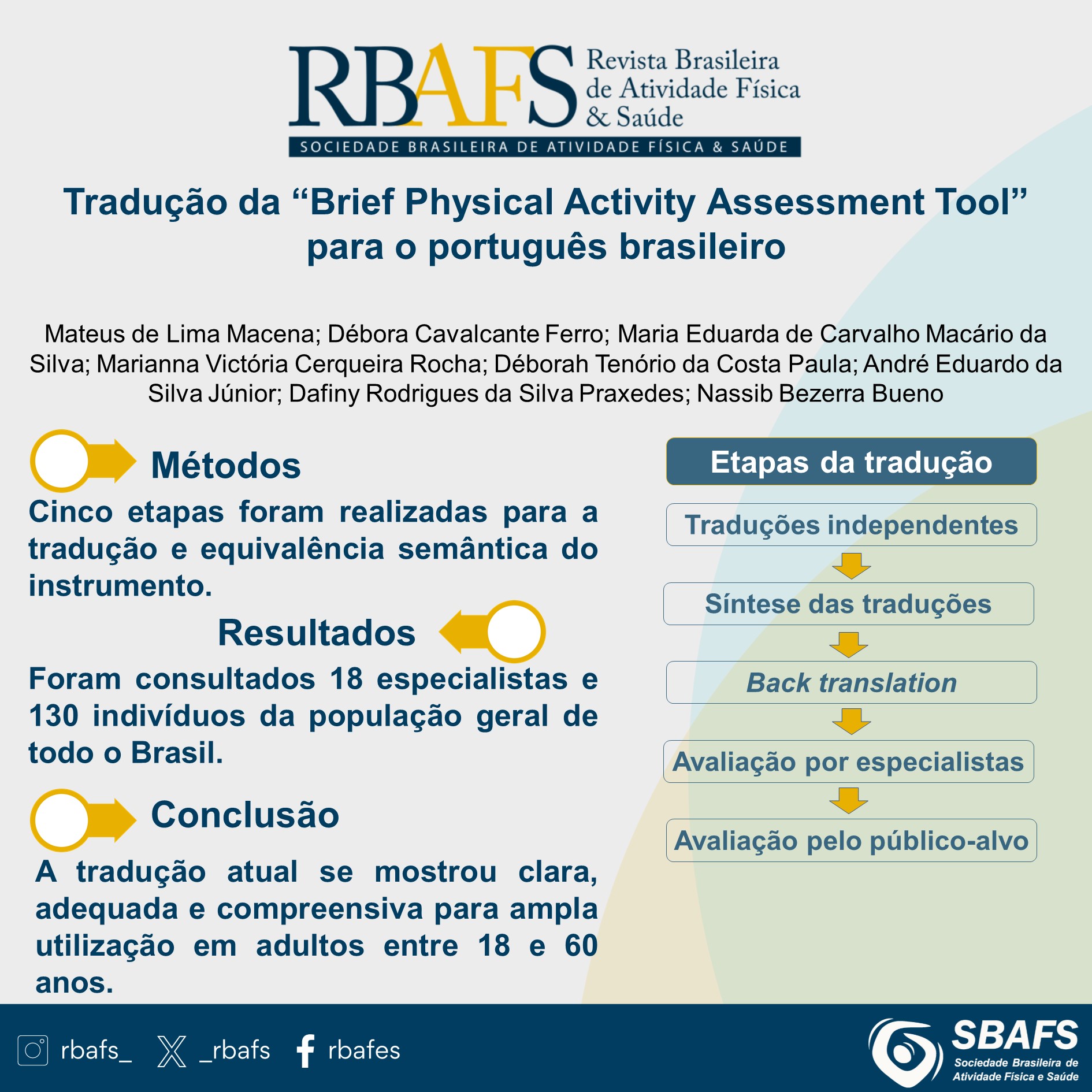Translation of the “Brief Physical Activity Assessment Tool” into Brazilian Portuguese
DOI:
https://doi.org/10.12820/rbafs.29e0345Keywords:
Physical activity, Exercise, Questionnaire, Sedentarism, TranslationAbstract
The Brief Physical Activity Assessment Tool (BPAAT) is a practical, valid, and easily applicable tool for assessing the level of physical activity in population studies or primary healthcare settings. The translation and semantic equivalence of this tool into Brazilian Portuguese are crucial for future studies and its integration into the daily routine of healthcare professionals. Therefore, the objective of this study was to propose the translation and establish semantic equivalence of the BPAAT tool in Brazilian Portuguese. The study was conducted using a digital platform, recruiting adult individuals (aged 18-60) from the five regions of Brazil. Five steps were carried out for the translation and semantic equivalence of the tool: translation of the instruments from the source language (English) to the target language (Brazilian Portuguese); synthesis of the translations; back translation; evaluation by an expert committee; and evaluation of the instruments by the target population. A total of 18 experts in the field and 130 individuals from the general population were consulted to evaluate the translation of the tool. On average, both groups of evaluators rated the clarity, adequacy, and understanding of the two questions in the BPAAT with a score of ≥ 4 out of 5. Additionally, both groups provided suggestions regarding the inclusion of examples of physical activities and suggested word replacements. The current version presented shows satisfactory scores for clarity, adequacy, and understanding among the general population, thus enabling its extensive utilization in primary healthcare and Brazilian scientific research.
Downloads
References
Malta DC, Duncan BB, Schmidt MI, Teixeira R, Ribeiro ALP, Felisbino-Mendes MS, et al. Trends in mortality due to non-communicable diseases in the Brazilian adult population: national and subnational estimates and projections for 2030. Popul Health Metr. 2020;18(Suppl 1):16. doi: https://doi.org/10.1186/s12963-020-00216-1. DOI: https://doi.org/10.1186/s12963-020-00216-1
World Health Organization. World Health Statistics 2021: A visual summary. Genebra: World Health Organization; 2021. Available from: https://www.who.int/data/stories/world-health-statistics-2021-a-visual-summary. [2023 Julho].
Brasil. Ministério da Saúde. Panorama da mortalidade por doenças crônicas não transmissíveis no Brasil. Coordenação-Geral de Vigilância de Agravos e Doenças Não Transmissíveis do Departamento de Análise em Saúde e Vigilância das Doenças Não Transmissíveis: Ministério da Saúde. 2023. Available from: https://www.gov.br/saude/pt-br/centrais-de-conteudo/publicacoes/boletins/epidemiologicos/edicoes/2021/boletim_epidemiologico_svs_23.pdf/view. [2023 Julho].
Crooke R, Haseler C, Haseler T, Collins J, Crockett A. Physical activity and moving more for health. J R Coll Physicians Edinb. 2020;50(2):173-80. Doi: https://doi.org/10.4997/JRCPE.2020.223. DOI: https://doi.org/10.4997/jrcpe.2020.223
World Health Organization. WHO guidelines on physical activity and sedentary behaviour. Genebra: World Health Organization; 2020. Available from: https://www.who.int/publications/i/item/9789240015128. [2023 Julho].
Varela AR, Pratt M, Kohn ER, Hallal PC. O Observatório Global de Atividade Física: um panorama sobre duas pandemias. Rev Bras Ativ Fís Saúde. 2021;26:1-3. doi: https://doi.org/10.12820/rbafs.26e0205. DOI: https://doi.org/10.12820/rbafs.26e0205
Dollman J, Okely AD, Hardy L, Timperio A, Salmon J, Hills AP. A hitchhiker’s guide to assessing young people’s physical activity: Deciding what method to use. J Sci Med Sport. 2009;12(5):518-25. doi: https://doi.org/10.1016/j.jsams.2008.09.007. DOI: https://doi.org/10.1016/j.jsams.2008.09.007
Marshall AL, Smith BJ, Bauman AE, Kaur S. Reliability and validity of a brief physical activity assessment for use by family doctors. Br J Sports Med. 2005;39(5):294-7. doi: https://doi.org/10.1136/bjsm.2004.013771. DOI: https://doi.org/10.1136/bjsm.2004.013771
Puig-Ribera A, Chimenis OP, Bosch MR, Bellido ED, Tebar AH, Gonfaus MS, et al. Cómo identificar la inactividad física en atención primaria: validación de las versiones catalana y española de 2 cuestionarios breves. Aten Primaria. 2012;44(8):485-93. doi: https://doi.org/10.1016/j.aprim.2012.01.005. DOI: https://doi.org/10.1016/j.aprim.2012.01.005
Puig-Ribera A, Martín-Cantera C, Puigdomenech E, Real J, Romaguera M, Magdalena-Belio JF, et al. Screening Physical Activity in Family Practice: Validity of the Spanish Version of a Brief Physical Activity Questionnaire. PLoS One. 2015;10(9):e0136870. doi: https://doi.org/10.1371/journal.pone.0136870. DOI: https://doi.org/10.1371/journal.pone.0136870
Beaton DE, Bombardier C, Guillemin F, Ferraz MB. Guidelines for the Process of Cross-Cultural Adaptation of Self-Report Measures. Spine. 2000;25(24):3186-91. doi: https://doi.org/10.1097/00007632-200012150-00014. DOI: https://doi.org/10.1097/00007632-200012150-00014
Associação Brasileira de Empresas de Pesquisas - ABEP. Critérios de classificação econômica Brasil. São Paulo: ABEP; 2021. Available from: https://www.abep.org/criterio-brasil. [2023 Fevereiro].
World Health Organization. Physical Status: the Use and Interpretation of Anthropometry. Genebra: World Health Organization; 1995.
Silva MPD, Fontana F, Campos JG, Mazzardo O, Lima DF, Paludo AC, et al. Time trends of physical inactivity in Brazilian adults from 2009 to 2017. Rev Assoc Med Bras (1992). 2021;67(5):681-9. doi: https://doi.org/10.1590/1806-9282.20201077. DOI: https://doi.org/10.1590/1806-9282.20201077
Strath SJ, Kaminsky LA, Ainsworth BE, Ekelund U, Freedson PS, Gary RA, et al. Guide to the assessment of physical activity: Clinical and research applications: a scientific statement from the American Heart Association. Circulation. 2013;128(20):2259-79. doi: https://doi.org/10.1161/01.cir.0000435708.67487.da. DOI: https://doi.org/10.1161/01.cir.0000435708.67487.da
Sallis R. Developing healthcare systems to support exercise: exercise as the fifth vital sign. Br J Sports Med. 2011;45(6):473-4. doi: https://doi.org/10.1136/bjsm.2010.083469. DOI: https://doi.org/10.1136/bjsm.2010.083469
Wendt A, Carvalho WRG, Silva ICM, Mielke GI. Preferências de atividade física em adultos brasileiros: resultados da Pesquisa Nacional de Saúde. Rev Bras Ativ Fís Saúde. 2019;24:1–9. doi: https://doi.org/10.12820/rbafs.24e0079. DOI: https://doi.org/10.12820/rbafs.24e0079
Wood ER, Silva AC, Baptista GG, Lüdorf SMA. Tornando-se um praticante de CrossFit: gerenciamentos do corpo dentro e fora dos boxes. Movimento.2022;28:e28038. doi: https://doi.org/10.22456/1982-8918.116972. DOI: https://doi.org/10.22456/1982-8918.116972
Brasil. Ministério da Saúde. Guia de Atividade Física para a População Brasileira [recurso eletrônico]. Ministério da Saúde, Secretaria de Atenção Primária à Saúde, Departamento de Promoção da Saúde.Brasília: Ministério da Saúde. 2021.

Downloads
Published
How to Cite
Issue
Section
License
Copyright (c) 2024 Mateus de Lima Macena, Débora Cavalcante Ferro, Maria Eduarda de Carvalho Macário da Silva, Marianna Victória Cerqueira Rocha, Déborah Tenório da Costa Paula, André Eduardo Silva Júnior, Dafiny Rodrigues Silva Praxedes, Nassib Bezerra Bueno

This work is licensed under a Creative Commons Attribution 4.0 International License.
When submitting a manuscript to the Revista Brasileira de Atividade Física & Saúde, the authors retain the copyright to the article and authorize the Revista Brasileira de Atividade Física & Saúde to publish the manuscript under the Creative Commons Attribution 4.0 License and identify it as the original publication source.


